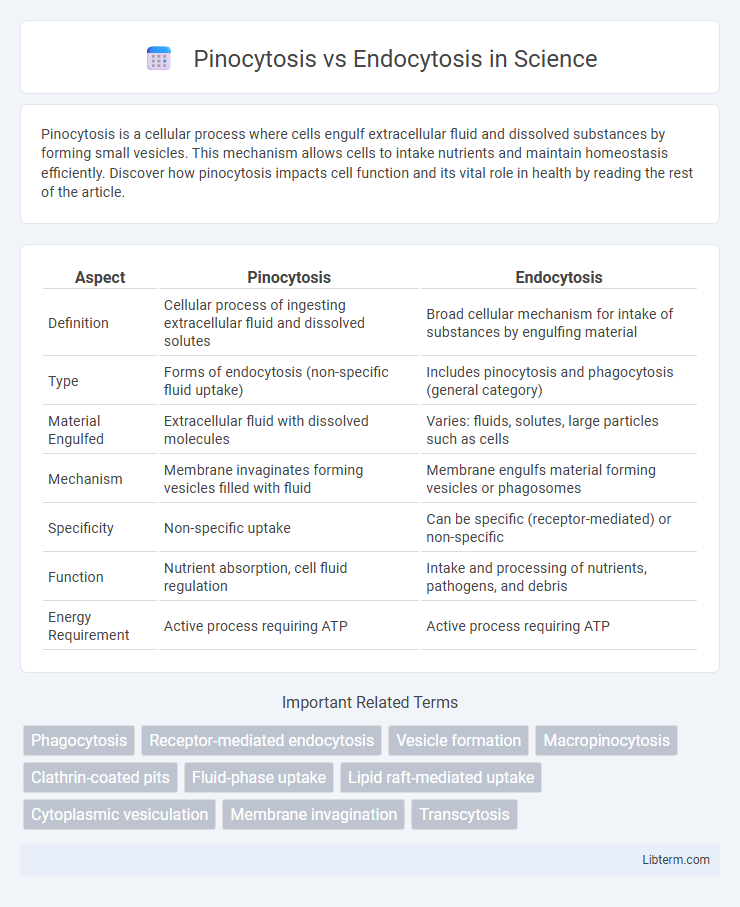Pinocytosis is a cellular process where cells engulf extracellular fluid and dissolved substances by forming small vesicles. This mechanism allows cells to intake nutrients and maintain homeostasis efficiently. Discover how pinocytosis impacts cell function and its vital role in health by reading the rest of the article.
Table of Comparison
| Aspect | Pinocytosis | Endocytosis |
|---|---|---|
| Definition | Cellular process of ingesting extracellular fluid and dissolved solutes | Broad cellular mechanism for intake of substances by engulfing material |
| Type | Forms of endocytosis (non-specific fluid uptake) | Includes pinocytosis and phagocytosis (general category) |
| Material Engulfed | Extracellular fluid with dissolved molecules | Varies: fluids, solutes, large particles such as cells |
| Mechanism | Membrane invaginates forming vesicles filled with fluid | Membrane engulfs material forming vesicles or phagosomes |
| Specificity | Non-specific uptake | Can be specific (receptor-mediated) or non-specific |
| Function | Nutrient absorption, cell fluid regulation | Intake and processing of nutrients, pathogens, and debris |
| Energy Requirement | Active process requiring ATP | Active process requiring ATP |
Introduction to Cellular Uptake Mechanisms
Endocytosis is a cellular uptake mechanism involving the engulfment of extracellular material through membrane invagination, forming vesicles for internalization. Pinocytosis, a subtype of endocytosis, specifically engulfs extracellular fluid and small solutes nonspecifically, enabling nutrient absorption and membrane turnover. Both processes are essential for cellular nutrient acquisition, receptor-mediated signaling, and maintaining homeostasis within eukaryotic cells.
Defining Endocytosis: Overview and Types
Endocytosis is a cellular process where cells engulf external substances by enclosing them in vesicles formed from the plasma membrane, enabling nutrient intake and signaling regulation. It primarily includes phagocytosis for large particles, pinocytosis for fluid and dissolved solutes, and receptor-mediated endocytosis targeting specific molecules via receptors. This mechanism is essential for maintaining cellular homeostasis and mediating responses to environmental changes.
What is Pinocytosis?
Pinocytosis is a specific form of endocytosis where cells ingest extracellular fluid and dissolved solutes by engulfing them into small vesicles, allowing nutrient absorption and cellular homeostasis. This process is non-specific, capturing a variety of molecules rather than targeting specific substances through receptors. Pinocytosis plays a critical role in nutrient uptake in many cell types, including endothelial and epithelial cells.
Pinocytosis vs Endocytosis: Key Differences
Pinocytosis is a form of endocytosis specifically involving the nonspecific uptake of extracellular fluid and solutes through small vesicles, while endocytosis broadly refers to the cellular process of engulfing various substances through membrane invaginations. Key differences include pinocytosis targeting fluid-phase uptake for nutrient absorption and cellular signaling, whereas endocytosis encompasses both pinocytosis and receptor-mediated endocytosis, the latter being selective for specific molecules. Pinocytosis typically occurs continuously in most cells, whereas endocytosis varies based on cell type and stimulus.
Mechanisms of Endocytosis
Endocytosis encompasses multiple cellular mechanisms for internalizing extracellular material, including phagocytosis, pinocytosis, and receptor-mediated endocytosis. Pinocytosis specifically involves the nonspecific engulfment of extracellular fluid and solutes via small vesicles formed by the invagination of the plasma membrane. Receptor-mediated endocytosis, a more selective process, requires ligand binding to cell surface receptors, triggering clathrin-coated pit formation and vesicle internalization for targeted uptake.
Mechanisms of Pinocytosis
Pinocytosis is a form of endocytosis where cells engulf extracellular fluid and dissolved solutes through small vesicles formed by the invagination of the plasma membrane. This mechanism involves the continuous formation of tiny, non-specific vesicles that internalize fluids, playing a key role in nutrient absorption and cell signaling. Unlike receptor-mediated endocytosis, pinocytosis does not require ligand binding and allows cells to sample their surrounding environment efficiently.
Biological Significance of Endocytosis
Endocytosis enables cells to actively internalize extracellular substances, including nutrients, signaling molecules, and pathogens, through membrane invagination forming vesicles. This process is crucial for cellular homeostasis, nutrient uptake, immune defense, and receptor-mediated signaling, allowing precise regulation of the cell's internal environment. Pinocytosis, a form of endocytosis, specifically facilitates the nonspecific uptake of extracellular fluid and small solutes, supporting nutrient absorption and membrane recycling.
Biological Roles of Pinocytosis
Pinocytosis plays a crucial role in cellular nutrient uptake by allowing cells to ingest extracellular fluids and dissolved solutes, ensuring essential molecular absorption. Unlike general endocytosis, pinocytosis specifically facilitates continuous sampling of the cell's environment to regulate homeostasis and maintain cellular metabolism. This process supports immune surveillance and signal transduction by internalizing signaling molecules and antigens for intracellular processing.
Similarities Between Pinocytosis and Endocytosis
Pinocytosis and endocytosis are cellular processes that involve the engulfment of extracellular materials through the plasma membrane to form vesicles. Both mechanisms utilize energy-dependent pathways and involve the remodeling of the cytoskeleton to internalize substances into the cell. These processes play critical roles in nutrient uptake, receptor-mediated signaling, and regulation of the cellular environment.
Conclusion: Choosing the Right Uptake Pathway
Selecting the appropriate uptake pathway depends on the cellular context and the nature of the substance being internalized, with pinocytosis specializing in the nonspecific engulfment of extracellular fluids and dissolved solutes. Endocytosis encompasses various mechanisms, including receptor-mediated endocytosis, which offers specificity and efficiency for targeted molecular uptake. Understanding these distinctions enables precise manipulation in drug delivery, nutrient absorption, and immune response modulation.
Pinocytosis Infographic

 libterm.com
libterm.com